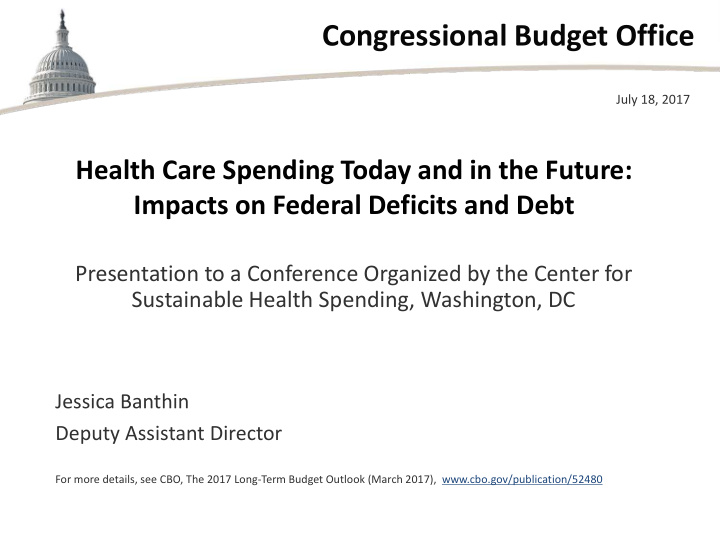



Congressional Budget Office July 18, 2017 Health Care Spending Today and in the Future: Impacts on Federal Deficits and Debt Presentation to a Conference Organized by the Center for Sustainable Health Spending, Washington, DC Jessica Banthin Deputy Assistant Director For more details, see CBO, The 2017 Long-Term Budget Outlook (March 2017), www.cbo.gov/publication/52480
An Overview of the Long-Term Budget Outlook 1 CONGRESSIONAL BUDGET OFFICE
If current laws governing taxes and spending did not change, the condition of the federal budget would worsen considerably over the next three decades. 2 CONGRESSIONAL BUDGET OFFICE
Growth in federal spending would continue to outpace growth in federal revenues, leading to ever larger budget deficits. 3 CONGRESSIONAL BUDGET OFFICE
Federal Spending and Revenues Percentage of Gross Domestic Product Actual Projected 4 CONGRESSIONAL BUDGET OFFICE
As a result, debt would grow larger in relation to the economy than ever recorded in U.S. history. 5 CONGRESSIONAL BUDGET OFFICE
Federal Debt Held by the Public Percentage of Gross Domestic Product 6 CONGRESSIONAL BUDGET OFFICE
Federal spending is projected to rise notably in relation to the economy because of growth in spending on Social Security, the major health care programs, and interest on the government’s debt. 7 CONGRESSIONAL BUDGET OFFICE
Components of Federal Spending Percentage of Gross Domestic Product 15 Actual Projected 10 Major Health Care Programs Other Noninterest Spending Social Security Net Interest 5 0 2000 2005 2010 2015 2020 2025 2030 2035 2040 2045 8 CONGRESSIONAL BUDGET OFFICE
Health Care Spending Today 9 CONGRESSIONAL BUDGET OFFICE
National Spending for Health Care, 2015 1 Medicare 5 6 10 CONGRESSIONAL BUDGET OFFICE
CBO defines outlays for the major health care programs as spending for: Medicare, • Medicaid, • Children’s Health Insurance Program (CHIP), and • Subsidies for health insurance purchased • through the marketplaces established under the Affordable Care Act and related spending. 11 CONGRESSIONAL BUDGET OFFICE
Net Outlays for Major Health Care Programs in 2017 Billions of Dollars Medicare 590 Medicaid 385 Health Insurance Subsidies and Related Spending 51 Children's Health Insurance Program 15 ____________ Total 1,041 12 CONGRESSIONAL BUDGET OFFICE
Health Care Spending in the Long-Term Budget Outlook 13 CONGRESSIONAL BUDGET OFFICE
If current laws generally remain unchanged, CBO projects that federal spending on the major health care programs would grow larger than any other category of spending. 14 CONGRESSIONAL BUDGET OFFICE
Spending in the Past and Under CBO’s Extended Baseline Percentage of Gross Domestic Product 15 CONGRESSIONAL BUDGET OFFICE
Spending on the major health care programs would account for 40 percent of federal noninterest spending in 2047, compared with 28 percent today. 16 CONGRESSIONAL BUDGET OFFICE
Composition of Federal Noninterest Spending Under CBO’s Extended Baseline Percent 17 CONGRESSIONAL BUDGET OFFICE
Spending on Medicare is projected to drive much of the growth in spending on major health care programs. 18 CONGRESSIONAL BUDGET OFFICE
Federal Spending on the Major Health Care Programs, by Category Percentage of Gross Domestic Product Projected 19 CONGRESSIONAL BUDGET OFFICE
Two factors explain the projected growth in spending on major health care programs: aging and rising health care costs per person, or excess cost growth. 20 CONGRESSIONAL BUDGET OFFICE
Projected Spending Growth in the Major Health Care Programs Percentage of Gross Domestic Product 21 CONGRESSIONAL BUDGET OFFICE
Population, by Age Group Millions of People 22 CONGRESSIONAL BUDGET OFFICE
Uncertainty in the Long-Term Projection 23 CONGRESSIONAL BUDGET OFFICE
Even if future tax and spending policies matched the policies specified under current law, budgetary outcomes would undoubtedly differ from CBO’s projections because of changes in the economy, demographics, and other factors, such as excess cost growth. 24 CONGRESSIONAL BUDGET OFFICE
Federal Debt Given Different Rates of Excess Cost Growth for Federal Spending on Medicare and Medicaid Percentage of Gross Domestic Product 250 Given Rates Actual Projected 1 Percentage Point Higher 206 200 Extended Baseline, With Excess Cost 150 Growth of 1 Percent 150 in 2047 Given Rates 109 100 1 Percentage Point Lower 50 0 2000 2005 2010 2015 2020 2025 2030 2035 2040 2045 25 CONGRESSIONAL BUDGET OFFICE
This presentation will be available on CBO’s website, www.cbo.gov. 26 CONGRESSIONAL BUDGET OFFICE
Recommend
More recommend